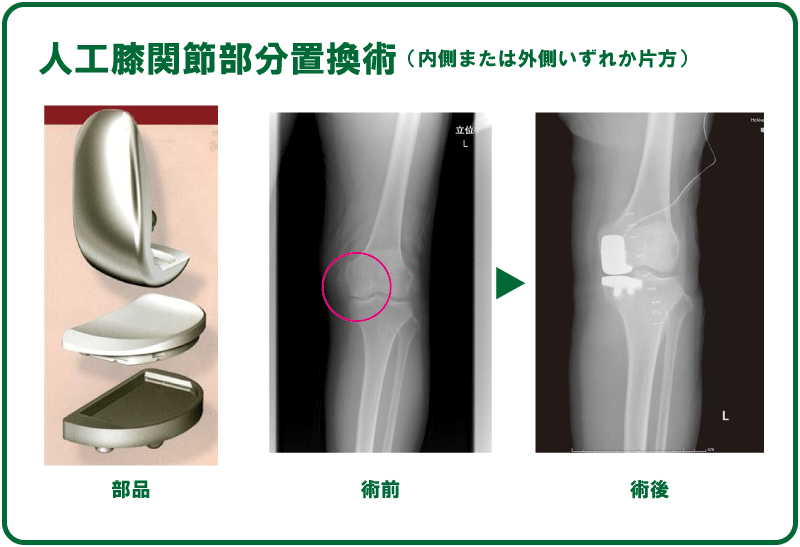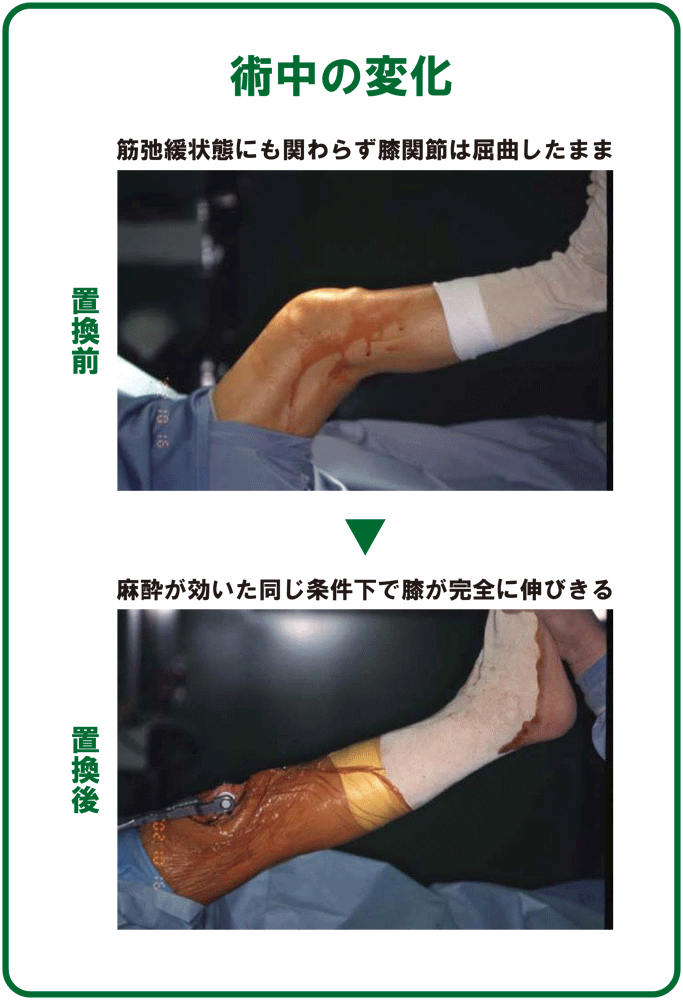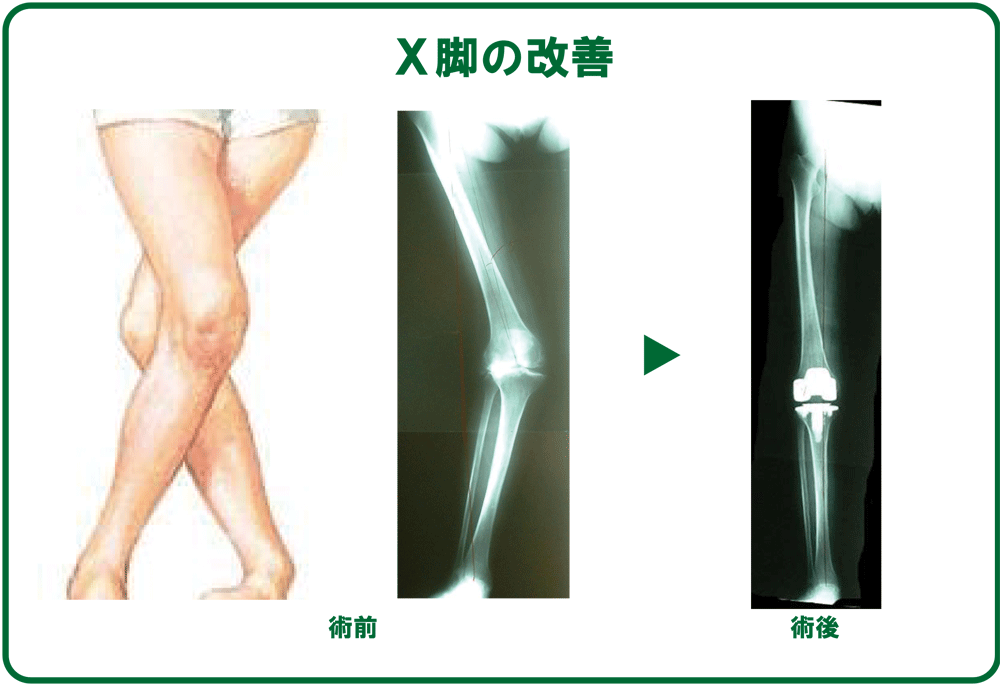


Man-made
Knee joint
Replacement technique
_edited.jpg)
What is total knee arthroplasty?
Outline of treatment and target patients
Total knee arthroplasty is a treatment method for people who have severe pain and cannot walk due to severe bone osteoarthritis.
It is indicated when medication, medication, or retirement homes are ineffective. In addition, we will make proposals in consideration of problems in daily life.
Material and life of the knee osteoarthritis
Artificial knee joints are made of polyethylene, metal and ceramic. In particular, resin cushioning material, which plays the role of cartilage, wears and damages with daily use and rotation of joints. Depending on the patient's physical condition, activity, weight, etc., until now it was necessary to replace the knee joint with a new one in 10 to 20 years.
The recently developed cushioning material made of ultra-high molecular weight polyethylene, which is resistant to wear, has made it possible to use the same artificial knee joint for a long period of time.
The skill of the doctor in charge also affects how long the artificial joint can be kept in good condition.
This is because different sizes are made in millimeters, and the connoisseur who chooses the most suitable size, thickness, and length for the patient is required. In addition, advanced techniques such as detailed adjustment of the depth and angle of bone cutting and precise observation eyes also greatly affect the service life.

.jpg)
The parts consist of special alloy femur and tibial parts, special plastic artificial cartilage, and patella parts.
.jpg)
.jpg)
About surgery
Outline and type of surgery
Roughly speaking, total knee arthroplasty is a flow in which the joint surface is trimmed by the thickness of the part to prepare the surface and the artificial joint is installed. It has been carried out all over the world for more than 40 years, and efforts are being made to improve artificial joints and stabilize surgery.
As shown on the right, the types are roughly divided into artificial knee joint partial replacement, which partially replaces either the medial or lateral side, and artificial knee joint total replacement, which replaces the entire knee joint.
■ Partial knee osteoarthritis
Applicable when wear or damage is only on the medial or lateral side of the knee and the rest is healthy. It is an operation to preserve the healthy part and replace only the part.
【Demerit】
It cannot be used for those who have severe leg curvature, ruptured knee ligaments, or poor knee extension / contraction angle.
In other words, the patients who are eligible are limited.
The long-term results are still unclear.
【merit】
Since the thickness and area of bone scraping are small, the burden on the body is light and relatively small surgery is required.
■ Total knee osteoarthritis
It is an operation that can be performed even for patients with severe cartilage and bone wear.
【Features】
It is also suitable for patients with damage to the cruciate ligament.
It is also possible to treat severe O-legs and X-legs straight.
For patients with unstable knees due to rupture of the knee ligament and patients with bent legs, the symptoms can be improved by using special parts.
In addition, since the entire knee is supported by sturdy parts, long-term results are stable.
Approximately 90% of all knee osteoarthritis performed worldwide is said to be total replacement.




Propose the best treatment
We will examine each patient's medical condition, hobbies, occupation, lifestyle, etc., and consider the best treatment method for each patient.
As a result of examination, even when proposing total replacement surgery, we will provide the best treatment with the latest surgical technique that can perform accurate parts installation with as little burden on the body as possible.

Utilizing treatment experience of over 1000 cases
In principle, the director has experience of more than 1000 cases such as revision surgery and difficult surgery such as severe deformity. If you have any concerns or doubts, please do not hesitate to ask. We will carefully explain until you are satisfied and relieved.
Overview of surgery and changes due to surgery
● Implement preoperative planning
An X-ray examination is performed, and an artificial knee joint that matches the size and shape of each patient's knee is selected. Consider the position and so on.
● Surgery time
It's about an hour and a half.
Surgery time will be longer in special cases and revisions.
● Wound (range of incision)
It is about 10 cm in front of the knee.
● Anesthesia
Perform both general anesthesia and lower body anesthesia.
Some patients may only have general anesthesia.
● Blood transfusion
90% of patients do not need it.
About 10% of patients who are prone to anemia will be transfused with blood received from the blood center.
● Adhesion of bone and artificial knee joint
Instantly fix with bone cement.
● Intraoperative changes
The knee, which did not stretch even in the anesthetized muscle relaxant state, will be fully stretched during surgery.
● Postoperative changes
The movement and posture of the joints and the balance of the whole body are also improved, and the gait is significantly improved.



Postoperative precautions
The most important thing to watch out for in your daily life is a fall.
As you can see in the picture below, you may have a hard time with your own knee joint instead of the artificial knee joint.
Also, even if the accuracy of the knee osteoarthritis is improved, it does not mean that it will be permanently dealt with.
The strength and durability of artificial joints does not reach that of a healthy person's knee.
Looseness between the knee osteoarthritis and your own bone
Cushion material wears out, acting as cartilage
Such a situation can occur.
It is essential that you visit the outpatient clinic regularly even after you are discharged to check if there are any changes or abnormalities in your knees. If any defects are found, reoperation will be required.
Maintain proper weight
Avoid carrying heavy objects
Use handrails for stairs
Do not do high-impact exercise (running, jumping, etc.)
Don't fall
It is important to keep in mind such things in daily life.
Total knee arthroplasty is a treatment that will last a lifetime with the total knee arthroplasty.
We strongly recommend that you keep in touch with your doctor on a regular basis after you leave the hospital.
Trouble that may occur after surgery



About rehabilitation
Rehabilitation started shortly after surgery
Standing and walking training will start the day after surgery or the day after surgery.
There is no long-term bed rest.
Elderly people may experience significant muscle weakness, bedsores, and dementia after spending a lot of time in bed. However, early walking training will help prevent the complications mentioned above.
The general flow until discharge is as shown in the table below.
The above is just a guide.
Some physically fit patients are discharged in about two weeks. If you are elderly and have no physical strength, some people will be discharged after taking more time to rehabilitate.
There are individual differences in the length of hospital stay.
